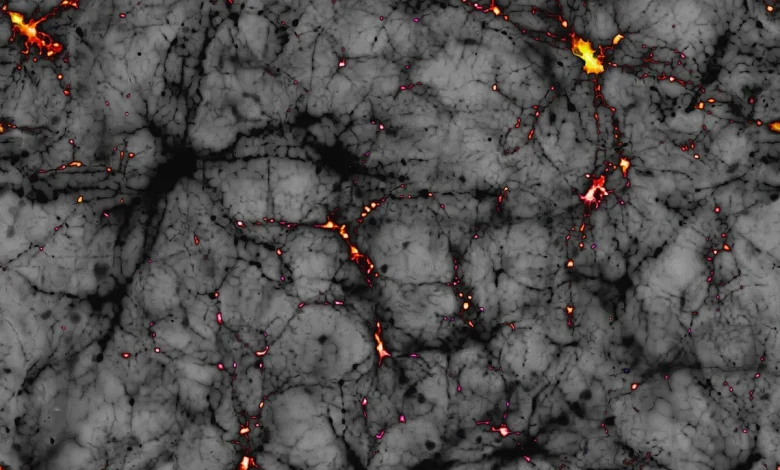A mysterious glow surrounding the Milky Way could be first evidence of dark matter

For nearly a century, dark matter has remained an enigma. Despite outnumbering normal matter five to one, it cannot be seen, touched or detected using any known techniques.
Now, a bold new analysis of 15 years of data from NASA’s Fermi Gamma-ray Space Telescope claims to have caught a glimpse.
The new study reports the detection of a mysterious halo-like glow of gamma rays around the Milky Way, peaking sharply at energies that closely match the kind of signal expected from a particular type of hypothetical dark matter particle.
Such particles, known as weakly interacting massive particles (WIMPs), could produce the gamma rays by colliding with each other in a process known as annihilation.
“If this is correct, to the extent of my knowledge, it would mark the first time humanity has ‘seen’ dark matter,” said Prof Tomonori Totani, an astronomer at the University of Tokyo and author of the study.
Speaking to BBC Science Focus, he added: “When I first spotted what seemed like a signal, I was sceptical. But when I took the time to check it meticulously and felt confident it was correct, I got goosebumps.”
Yet, exciting as the new signal is, independent experts say it’s far from the definitive answer.
The potential discovery comes almost 100 years after the Swiss astronomer Fritz Zwicky first theorised the existence of dark matter when he noticed galaxies within the Coma Cluster moving too fast for their visible mass.
Totani’s study, published in the Journal of Cosmology and Astroparticle Physics, examined 15 years of data from the Fermi telescope, honing in on the region above and below the main disk of the Milky Way known as the galactic halo.
After carefully modelling and subtracting known sources, including interstellar gas interactions, cosmic rays and the huge bubbles of high-energy plasma found above and below the Milky Way’s centre, he found a residual component that shouldn’t be there.
“We detected gamma rays with a photon energy of 20 gigaelectronvolts (or 20 billion electronvolts – an extremely large amount of energy) extending in a halo-like structure toward the centre of the Milky Way galaxy,” Totani said. “The gamma ray emission component closely matches the shape expected from the dark matter halo.”
A gigaelectronvolt, or GeV, is a unit physicists use to measure the energy of subatomic particles – roughly a billion times the energy picked up by a single electron when it moves across a one-volt battery.
The possible dark matter signal detected by Totani rises steeply from a few GeV, peaks sharply at roughly 20 GeV, and falls again. This curve matches predictions for WIMPs that have masses about 500 times that of a proton.
This gamma ray intensity map shows the signals possibly coming from dark matter around the Milky Way halo. The horizontal grey bar in the central region corresponds to the galactic plane area, which was excluded from the analysis to avoid strong astrophysical radiation – Photo credit: Tomonori Totani, The University of Tokyo
In Totani’s view, the data form a strong indication of dark matter annihilation. “This signifies a major development in astronomy and physics,” he said.
But Jan Conrad, a professor of astroparticle physics at Stockholm University in Sweden and an independent expert in gamma ray searches for dark matter, urges caution.
“It is notoriously difficult to make these claims with Fermi data,” he told BBC Science Focus.
Indeed, this is not the first time astronomers have seen something like this. As far back as 2009 – just a year after the Fermi telescope launched – scientists spotted an unexplained excess of gamma rays coming from the galactic centre.
For years, this finding has remained one of the strongest hints of dark matter. And yet, Conrad said, after 16 years the scientific community still hasn’t settled whether the signal is or isn’t dark matter.
“That was also attributed to dark matter,” he says. “And since then, with increased data and better methods, it’s still not resolved whether there could be dark matter there or not.”
Even today, he noted, researchers who have tried for over a decade to disprove the galactic centre excess have not been able to show conclusively that it must be astrophysical (from non-dark matter sources) – but they also cannot show it is dark matter. It remains unresolved.
The new signal in the halo is far less studied, Conrad said, and will likely require years of further research to verify. Both the new halo excess and the long-debated galactic centre signal share a fundamental problem: noise.
In these regions, gamma rays that might be from dark matter annihilation could also originate from a plethora of other sources, many of which are not even fully understood themselves. That makes drawing firm conclusions exceptionally hard.
“Because the backgrounds of astrophysical sources are so uncertain, it makes it very difficult to make strong claims,” Conrad said.
Despite their differing confidence levels, both Totani and Conrad point to the same next step: dwarf galaxies.
These small, faint galaxies orbiting the Milky Way are believed to be extremely rich in dark matter, yet their astrophysical gamma ray backgrounds are minimal. That makes them one of the cleanest possible laboratories for testing dark matter annihilation.
“If you see a similar excess in dwarf galaxies, that would be a strong hint,” Conrad said. “Dwarf galaxies are much cleaner so there could be a confirmation there.”
Totani agreed: “If the result of this study is correct, it would not be surprising to detect gamma rays from dwarf galaxies as well.”
The Cherenkov Telescope Array Observatory (CTAO) will be the most sensitive ground-based gamma ray observatory ever built, offering a powerful new way to test whether this mysterious signal truly comes from dark matter – Photo credit: Getty
But the gold standard confirmation of Totani’s findings may come far closer to home. Today, experiments buried deep underground aiming to detect dark matter are found all over the world.
“If you were to see a signal there consistent with a WIMP of the same mass… that would be a very, very strong argument for this because that’s much cleaner,” Conrad says.
And in the coming years, the next-generation Cherenkov Telescope Array Observatory (CTAO) will dramatically increase the sensitivity for high-energy gamma rays, allowing researchers to scrutinise the halo signal in even more detail.
“Of course, if it’s true, it’s a great discovery,” Conrad said. “We still don’t know what dark matter is. An unambiguous signal of dark matter particles would be fantastic – that’s clear,” Conrad said. “But this needs much more work in assessing what else there could be to explain this excess.”
Read more:





